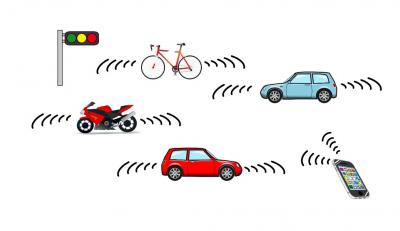New millimeter-wave technology could make future vehicles much safer

Millimeter-wave radars covering several tens of meters could be on cars, bikes, and smartphones. This might create a lot of new applications including games. Credit: Hiroshima University
The W-band covers the frequencies used by automotive radars. Sophisticated driver-assistance and selfdriving will require radars with millimeter-wave beam scanning capability that can “see” day and night and even in adverse weather conditions. Such a “phased array” will consist of up to hundreds of transmitters and receivers. Given the fact that even cars are becoming battery-operated, it is imperative that these circuits be low-power.
Lowering the power-supply voltage is the most effective means of accomplishing that. However, transistor performance drops with voltage and no W-band amplifier has so far operated at as low as 0.5 V . The team of researchers successfully demonstrated a W-band amplifier at 0.5 V by bringing together MIFS's DDC technology and design techniques developed by Hiroshima University. The DDC technology offers high-performance silicon MOS transistors even at low voltages and is currently available from MIFS as a 55-nm CMOS process. The design techniques further improve transistor and circuit performance at millimeter-wave frequencies.
“Now that seriously low-power W-band circuits seem really possible, we should think about what we can do with them. Applications aren't limited to automotive radars and high-speed communications between base stations. What if you have a radar on your smartphone? Today's smartphones can already sense things like acceleration, audible sound, visible light, and Earth's magnetic field.
But the only active probing device is that tiny LED (light-emitting diode) that can illuminate at most a few meters. Add a millimeter-wave radar on a smartphone, and it doesn't have to be a so-called primary radar, which only detects waves reflected back. Your smartphone could respond to waves from your friend's radar and send some signal back. A whole lot of new applications could be created including games,” said Prof. Minoru Fujishima, Graduate School of Advanced Sciences of Matter, Hiroshima University.
“Another significance of our 0.5-V W-band amplifier is reliability. We researchers know that some millimeter-wave circuits presented at major conferences, biased at 1 V or higher, won't last long. They degrade as you measure them, within days or even hours, not years, because of the so-called hot-carrier effects. You wouldn't want to get on a car that loses its sight so quickly. The 0.5-V supply voltage will significantly reduce hot-carrier generation,” Prof. Fujishima added.
“Compared to conventional CMOS, our DDC transistors offer excellent performance in low-power operations. We have proven that we can extend those outstanding qualities to the millimeter band. I am delighted that our collaboration with Hiroshima University has produced a millimeter-band amplifier. We plan to move forward by building a design environment for maximizing the capabilities of DDC technology,” said Mutsuaki Kai, Vice President of Technology Development, Mie Fujitsu Semiconductor.
The research group plans to continue exploring the possibility of low-voltage millimeter-wave CMOS circuits.
###
References [1] K. Katayama, S. Amakawa, K. Takano, T. Yoshida, M. Fujishima, K. Hisamitsu, and H. Takatsuka, “An 80−106 GHz CMOS amplifier with 0.5 V supply voltage,” IEEE Radio Frequency Integrated Circuits Symposium (RFIC), June 2017.
Media Contacts: Hiroshima University Public Relations Group Email: koho@office.hiroshima-u.ac.jp
Mie Fujitsu Semiconductor Limited Business Management Division, Public Relations Group Inquiry: https:/
Media Contact
Norifumi Miyokawa
pr-research@office.hiroshima-u.ac.jp
81-824-244-427
Media Contact
All latest news from the category: Information Technology
Here you can find a summary of innovations in the fields of information and data processing and up-to-date developments on IT equipment and hardware.
This area covers topics such as IT services, IT architectures, IT management and telecommunications.
Newest articles

NASA: Mystery of life’s handedness deepens
The mystery of why life uses molecules with specific orientations has deepened with a NASA-funded discovery that RNA — a key molecule thought to have potentially held the instructions for…

What are the effects of historic lithium mining on water quality?
Study reveals low levels of common contaminants but high levels of other elements in waters associated with an abandoned lithium mine. Lithium ore and mining waste from a historic lithium…

Quantum-inspired design boosts efficiency of heat-to-electricity conversion
Rice engineers take unconventional route to improving thermophotovoltaic systems. Researchers at Rice University have found a new way to improve a key element of thermophotovoltaic (TPV) systems, which convert heat…



